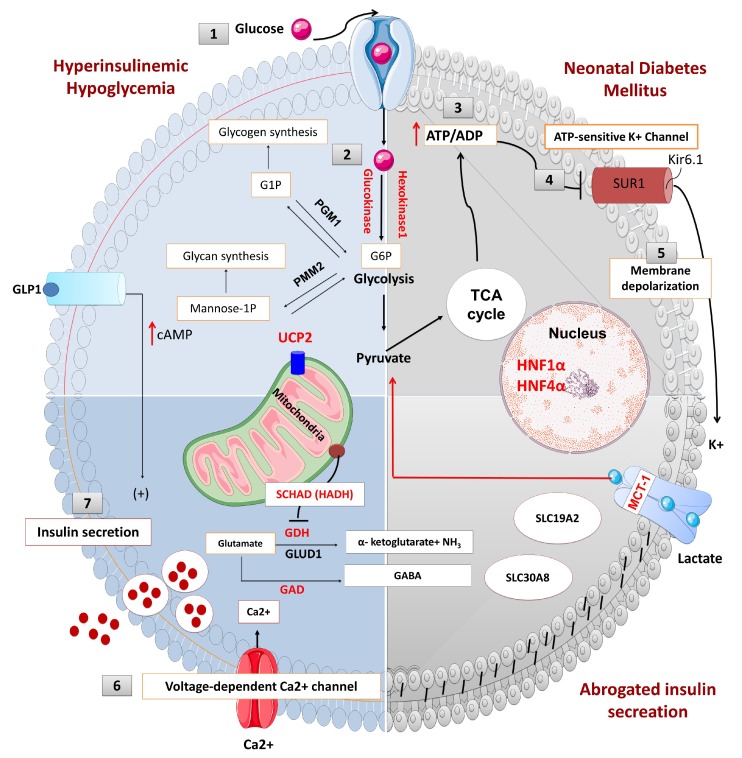Figure 1.
The physiology of insulin secretion from pancreatic beta-cells. Glucose enters into the beta cells through facilitative transport mediated by glucose transporter 2 (GLUT 2) (1) and is converted to glucose-6-phosphate by the enzyme glucokinase (2). Generation of high energy molecules such as adenosine triphosphate (ATP), leads to an increase in the ratio of ATP/ADP (adenosine diphosphate) (3). Elevated ATP/ADP ratio closes the ATP-sensitive potassium channel (KATP). The Kir6.2 subunits of the KATP channels are responsible for K+ ion efflux from the pancreatic beta-cell, and thus maintains a steady state membrane potential (4). The closure of the KATP channels results in a depolarization of the pancreatic beta-cell membrane and the activation of voltage-gated calcium channels located on the beta-cell membrane (5). Calcium enters into beta cells through these voltage-gated calcium channels (6), and the increase in intracellular calcium triggers secretory granule exocytosis and insulin release (7). In congenital hyperinsulinism, defects in the KATP channel or energy metabolism leading to prolonged closure of KATP channels, create a membrane potential between the inner and outer sites of the beta cell (depolarization) which is followed by the opening of the voltage-gated calcium channel and calcium influx. Constantly closed KATP channels or uncontrolled ATP generation uncouples the insulin secretion from the blood glucose level and causes inappropriate insulin secretion, despite low blood glucose. On the contrary, in neonatal diabetes mellitus (NDM), the KATP channel remains open and a constant efflux of K+ ion hyperpolarizes the beta cell. Lack of depolarization does not allow for voltage-gated calcium channel opening and insulin secretion despite elevated blood glucose. (Ca2+: calcium ions, cAMP: cyclic adenosine monophosphate, G1P: glucose-1-phosphate, G6P: glucose 6-phosphate, GABA: γ-aminobutyric acid, GAD: glutamate decarboxylase enzyme, GLUD1: glutamate dehydrogenase 1, GDH: glutamate dehydrogenase, GLP1: glucagon-like peptide 1, GLUT2: glucose transporter 2, HADH: hydroxy acyl-CoA dehydrogenase, HNF1α: hepatocyte nuclear factor 1α, HNF4α: hepatocyte nuclear factor 4α, K+: potassium, Kir6.2: inward rectifier potassium channel 6.2, MCT1: monocarboxylate transporter 1, NH3: ammonia, PGM1: phosphoglucomutase 1, PMM2: phosphomannomutase 2, SUR1: sulfonylurea receptor 1, TCA: tricarboxylic acid, UCP2: mitochondrial uncoupling protein 2).

